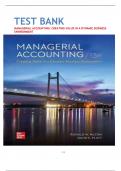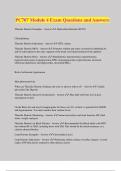TEST BANK
MANAGERIAL ACCOUNTING: CREATING VALUE IN A DYNAMIC BUSINESS
ENVIRONMENT
1-1
,Appendix I: The Sarbanes-Oxley Act, Internal Controls, and Management Accounting
Appendix II: Compound Interest and the Concept of Present Value
Appendix III: Inventory Management
Chapter 10: Standard Costing and Analysis of Direct Costs
Chapter 11: Flexible Budgeting and the Management of Overhead and Support Activity Costs
Chapter 12: Responsibility Accounting and the Balanced Scorecard
Chapter 13: Investment Centers and Transfer Pricing
Chapter 14: Decision Making: Relevant Costs and Benefits
Chapter 15: Target Costing and Cost Analysis for Pricing Decisions
Chapter 16: Capital Expenditure Decisions
Chapter 17: Allocation of Support Activity Costs and Joint Costs
1-2
, Appendix I
The Sarbanes-Oxley Act, Internal Controls, And Management
Accounting
Multiple Choice Questions
1. The Sarbanes-Oxley Act:
A. Arose Because Of Several Accounting Scandals That Rocked The Public's Confidence
InPublished Financial Statements.
B. Was Enacted, In Part, To Bring About Reform In Companies' Financial
Reporting Processes.
C. Has Distinct Guidelines For Reporting On An Organization's
Internal Control Practices.
D. Contains Provisions Whereby The Chief Executive Officer (CEO) And Chief
Financial Officer (CFO) Can Be Held Criminally Responsible If Their Firm's Financial
Statements Are Found To Be Fraudulent In Nature.
E. All Of The Other Answers
Are Correct.
2. Internal Controls Focus On All Of The Following Except:
A. Effectiveness
OfOperations.
B. Reliability Of
Financial Reporting.
C. Compliance With Applicable Laws
AndRegulations.
D. Maximization Of Profit And
CashFlows.
E. Efficiency
Of
Operations.
,3. Which Of The Following Is A Typical Internal Control?
A. The Use Of Password-Protected Computers
AndSoftware.
B. The Requirement That Separate Individuals Authorize Cash Disbursements
AndSign Checks.
C. The Use Of Physical Controls Over Inventories To Prevent
Loss From Theft.
D. A Physical Count Of Inventory At Year-End To Verify Amounts Shown On
TheCompany's Accounting Records.
E. All Of The Other Answers
Are Correct.
4. The Sarbanes-Oxley Act Established The:
A. Securities And Exchange Commission
(SEC).
B. Public Company Accounting Oversight Board
(PCAOB).
C. Financial Accounting Standards Board
(FASB).
D. Institute Of Management
Accountants(IMA).
E. American Accounting Association
(AAA).
5. Which Of The Following Bodies Oversees Audits And Auditors, And Sanctions Firms
AndIndividuals For Violations Of Laws And Regulations?
A. American Institute Of Certified Public
Accountants (AICPA).
B. American Accounting Association
(AAA).
C. Public Company Accounting Oversight Board
(PCAOB).
D. Financial Accounting Standards Board
(FASB).
E. Accounting Principles Board
(APB).
,6. Which Of The Following Is Not A Provision Of (Nor An Outgrowth Of) The Sarbanes-
Oxley Act?
A. A Public Company's Annual Report Must Contain A Separate Disclosure That
AssessesThe Company's Internal Controls.
B. Management Is Essentially Responsible For Establishing And
MaintainingInternal Controls.
C. A Company's Chief Executive Officer (CEO) And Chief Financial Officer (CFO) Can
BeHeld Criminally Responsible If Their Firm's Financial Statements Are Fraudulent.
D. A Company Must Prepare A Balance Sheet, An Income Statement, A Statement
OfStockholders' Equity, And A Statement Of Cash Flows.
E. A New Body, The Public Company Accounting Oversight Board, Oversees
AndInvestigates The Audits And Auditors Of Public Companies.
7. Which Of The Following Statements Regarding The Sarbanes-Oxley Act Is (Are) True?
A. Management Must Establish And Maintain A System Of Internal Controls
Over Financial Reporting.
B. Management Must Periodically Assess A Company's System Of Internal Controls
Over Financial Reporting.
C. Management Must Include In The Company's Annual Report A Separate Report
That Assesses Internal Controls.
D. A Company's Auditors Are Required To Report On Management's Assessment
OfInternal Controls.
E. All Of The Other Answers
Are Correct.
8. The Provisions Of Sections 302 And 404 Of The Sarbanes-Oxley Act (As
Originally Enacted) Have Proved Especially Troublesome For:
A. Small
Businesses.
B. Private
Universities
.
C. Cities And
Municipalities.
D. Healthcare
Providers.
E. Individual
Taxpayers
.
,9. The Provisions Of Section 302 Of The Sarbanes-Oxley Act (As Originally Enacted)
Require The Signing Officers Of A Company To Do All Of The Following Except:
A. Audit The Internal Controls Over
Financial Reporting.
B. Establish The Internal Controls Over
Financial Reporting.
C. Maintain The Internal Controls Over
FinancialReporting.
D. Evaluate The Internal Controls Over
FinancialReporting.
E. Disclose Material Weaknesses In The Internal Controls Over
Financial Reporting.
10. Section 404 Of The Sarbanes-Oxley Act, Management Assessment Of Internal
Controls,Includes All Of The Following Except:
A. A Statement Of Management's Responsibility For Establishing The
InternalControl Structure.
B. A Waiver Of Auditor Responsibility For Assessing Management's Report
OnInternal Controls.
C. An Assessment Of The Effectiveness Of Internal Controls
By Management.
D. An Assessment Of The Effectiveness Of Procedures For Financial Reporting
By Management.
E. A Requirement That Management Include In Its Annual Report An
Internal Control Report.
11. To Achieve The Objectives Of Sections 302 And 404 Of The Sarbanes-Oxley
Act, Management And Independent Auditors Should:
A. Disclose The Minutia Of The Internal
Control Structure.
B. Conduct A Cost-Benefit Analysis Prior To Deciding Whether Or Not To
Adopt These Sections.
C. Emphasize Those Areas Where The Greatest Risk Of Fraud Or Material Misstatement
IsLikely To Occur.
D. Analyze All Financial Transactions That Are Included In The Reported
Financial Statements.
E. Work Together To Design The Most Effective
InternalControl System.
,12. Most Of The Sarbanes-Oxley Act Relates Primarily To:
A. Corporate
Governance.
B. Financial
Accounting.
C. Auditin
G.
D. Court-Invoked Penalties For
Violating The Law.
E. All Of The Other Answers
Are Correct.
13. Which Of The Following Statements Is False Concerning Computerized
Accounting Systems?
A. Safeguards Exist To Make Sure That Controls Are
Working Properly.
B. There Is No Need For Controls Over Human Operators Of
Computerized Systems.
C. Computerized Accounting Systems Are Not
100% Reliable.
D. Limits Should Be Placed On Who Can Access A
Computerized System.
E. Many Internal Control Procedures
AreAutomated.
14. Under Section 404 Of The Sarbanes-Oxley Act, Auditors Are Required To:
A. Attest To And Report On Management's Assessment Of
Internal Controls.
B. Establish And Maintain Internal Controls For
AuditedCompanies.
C. Advise Management On Its Preparation Of The Report On
Internal Controls.
D. Evaluate The Company's Internal Control System
Periodically Throughout The Year.
E. All Of The Other Answers
Are Correct.
, Appendix I The Sarbanes-Oxley Act, Internal Controls, And
Management Accounting Answer Key
Multiple Choice Questions
1. The Sarbanes-Oxley Act:
A. Arose Because Of Several Accounting Scandals That Rocked The
Public's Confidence In Published Financial Statements.
B. Was Enacted, In Part, To Bring About Reform In Companies' Financial
Reporting Processes.
C. Has Distinct Guidelines For Reporting On An Organization's
Internal Control Practices.
D. Contains Provisions Whereby The Chief Executive Officer (CEO) And Chief
Financial Officer (CFO) Can Be Held Criminally Responsible If Their Firm's
Financial Statements Are Found To Be Fraudulent In Nature.
E. All Of The Other Answers
Are Correct.
AACSB: Ethics
AICPA BB: Legal
AICPA FN: Risk Analysis
Blooms: Understand
Difficulty: 1 Easy
Learning Objective: I-01 Understand And Discuss The Concept Of Internal Controls Over Financial Reporting.
2. Internal Controls Focus On All Of The Following Except:
A. Effectiveness
OfOperations.
B. Reliability Of
Financial Reporting.
C. Compliance With Applicable Laws
AndRegulations.
D. Maximization Of Profit And
CashFlows.
E. Efficiency
Of
Operations.
AACSB: Ethics
, AICPA BB: Industry
AICPA FN: Risk Analysis
Blooms: Understand
Difficulty: 2 Medium
Learning Objective: I-01 Understand And Discuss The Concept Of Internal Controls Over Financial Reporting.
3. Which Of The Following Is A Typical Internal Control?
A. The Use Of Password-Protected Computers
AndSoftware.
B. The Requirement That Separate Individuals Authorize Cash Disbursements
AndSign Checks.
C. The Use Of Physical Controls Over Inventories To Prevent
Loss From Theft.
D. A Physical Count Of Inventory At Year-End To Verify Amounts Shown On
TheCompany's Accounting Records.
E. All Of The Other Answers
Are Correct.
AACSB: Ethics
AICPA BB: Industry
AICPA FN: Risk Analysis
Blooms: Understand
Difficulty: 2 Medium
Learning Objective: I-01 Understand And Discuss The Concept Of Internal Controls Over Financial Reporting.
4. The Sarbanes-Oxley Act Established The:
A. Securities And Exchange Commission
(SEC).
B. Public Company Accounting Oversight Board
(PCAOB).
C. Financial Accounting Standards Board
(FASB).
D. Institute Of Management
Accountants (IMA).
E. American Accounting Association
(AAA).
AACSB: Ethics
AICPA BB: Legal
AICPA FN: Research
Blooms: Understand
Difficulty: 2 Medium
Learning Objective: I-02 Understand And Discuss The Role Of The PCAOB And The Implications Of Sarbanes-Oxley
Sections 302 And 404.
, 5. Which Of The Following Bodies Oversees Audits And Auditors, And Sanctions
Firms And Individuals For Violations Of Laws And Regulations?
A. American Institute Of Certified Public
Accountants (AICPA).
B. American Accounting Association
(AAA).
C. Public Company Accounting Oversight Board
(PCAOB).
D. Financial Accounting Standards Board
(FASB).
E. Accounting Principles Board
(APB).
AACSB: Ethics
AICPA BB: Industry
AICPA FN: Research
Blooms: Understand
Difficulty: 2 Medium
Learning Objective: I-02 Understand And Discuss The Role Of The PCAOB And The Implications Of Sarbanes-Oxley
Sections 302 And 404.
6. Which Of The Following Is Not A Provision Of (Nor An Outgrowth Of) The
Sarbanes-Oxley Act?
A. A Public Company's Annual Report Must Contain A Separate Disclosure
That Assesses The Company's Internal Controls.
B. Management Is Essentially Responsible For Establishing And
MaintainingInternal Controls.
C. A Company's Chief Executive Officer (CEO) And Chief Financial Officer (CFO)
CanBe Held Criminally Responsible If Their Firm's Financial Statements Are
Fraudulent.
D. A Company Must Prepare A Balance Sheet, An Income Statement, A Statement
OfStockholders' Equity, And A Statement Of Cash Flows.
E. A New Body, The Public Company Accounting Oversight Board, Oversees
AndInvestigates The Audits And Auditors Of Public Companies.
AACSB: Ethics
AICPA BB: Industry
AICPA FN: Research
Blooms: Understand
Difficulty: 2 Medium
Learning Objective: I-02 Understand And Discuss The Role Of The PCAOB And The Implications Of Sarbanes-Oxley
Sections 302 And 404.






